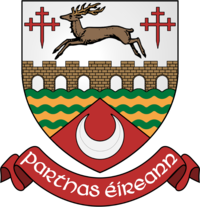Our website is made possible by displaying online advertisements to our visitors.
Please consider supporting us by disabling your ad blocker.
Buncrana
Buncrana
Bun Cranncha | |
|---|---|
Town | |
 Buncrana from the south | |
| Motto(s): Aoibhinn Linn Áille na hÁite Seo (Irish) "sweet to us is the beauty of this place" | |
| Coordinates: 55°08′11″N 7°27′22″W / 55.1364°N 7.4560°W | |
| Country | Ireland |
| Province | Ulster |
| County | County Donegal |
| Barony | Inishowen West |
| Dáil Éireann | Donegal |
| EU Parliament | Midlands–North-West |
| Elevation | 62 m (203 ft) |
| Population | 6,971 |
| Time zone | UTC±0 (WET) |
| • Summer (DST) | UTC+1 (IST) |
| Eircode routing key | F93 |
| Telephone area code | +353(0)74 |
| Irish Grid Reference | C346320 |
| Year | Pop. | ±% |
|---|---|---|
| 1821 | 198 | — |
| 1831 | 1,059 | +434.8% |
| 1841 | 961 | −9.3% |
| 1851 | 797 | −17.1% |
| 1861 | 686 | −13.9% |
| 1871 | 755 | +10.1% |
| 1881 | 764 | +1.2% |
| 1891 | 735 | −3.8% |
| 1901 | 1,316 | +79.0% |
| 1911 | 1,848 | +40.4% |
| 1926 | 2,309 | +24.9% |
| 1936 | 2,295 | −0.6% |
| 1946 | 2,729 | +18.9% |
| 1951 | 3,039 | +11.4% |
| 1956 | 3,064 | +0.8% |
| 1961 | 3,165 | +3.3% |
| 1966 | 3,115 | −1.6% |
| 1971 | 3,334 | +7.0% |
| 1981 | 3,938 | +18.1% |
| 1986 | 4,131 | +4.9% |
| 1991 | 4,388 | +6.2% |
| 1996 | 4,805 | +9.5% |
| 2002 | 5,271 | +9.7% |
| 2006 | 5,911 | +12.1% |
| 2011 | 6,839 | +15.7% |
| 2016 | 6,785 | −0.8% |
| 2022 | 6,971 | +2.7% |
| [1][2] | ||
Buncrana (/ˈbʌnkrænə/ bun-KRA-NA; Irish: Bun Cranncha, meaning 'foot of the (River) Crana') is a town in Inishowen in the north of County Donegal in Ulster, the northern province in Ireland. The town sits on the eastern shores of Lough Swilly, being 23 kilometres (14 mi) northwest of Derry and 43 kilometres (27 mi) north of Letterkenny.[3] In the 2022 census, the population was 6,971,[1] making it the second most populous town in County Donegal, after Letterkenny, and the largest in Inishowen.
Buncrana is the historic home of the Ó Dochartaigh (O'Doherty) clan and originally developed as a town around the defensive tower known as O'Doherty's Keep, at the mouth of the River Crana. The town was moved to its present location, just south of the River Crana, when George Vaughan had the current Main Street laid out in 1718.
The town was a major centre for the textile industry in County Donegal from the 19th century until the mid-2000s (decade).
- ^ a b c "Interactive Data Visualisations: Towns: Buncrana". Census 2022. Central Statistics Office. Retrieved 26 September 2023.
- ^ "CSO: Census: Census Home Page". Archived from the original on 20 September 2010. Retrieved 6 July 2012. and www.histpop.org. Post 1961 figures include environs of Buncrana. For a discussion on the accuracy of pre-famine census returns see J. J. Lee "On the accuracy of the pre-famine Irish censuses" in Irish Population, Economy and Society edited by JM Goldstrom and LA Clarkson (1981) p. 54, and also "New Developments in Irish Population History, 1700–1850" by Joel Mokyr and Cormac Ó Gráda in The Economic History Review, New Series, Vol. 37, No. 4 (November , 1984), pp. 473–488.
- ^ "Town information: location". buncrana.com. Archived from the original on 7 October 2011. Retrieved 15 October 2011.
Previous Page Next Page




